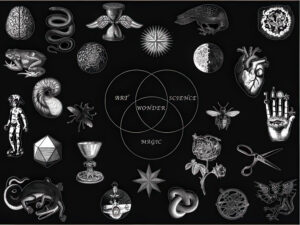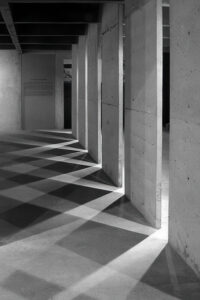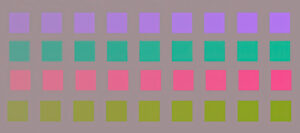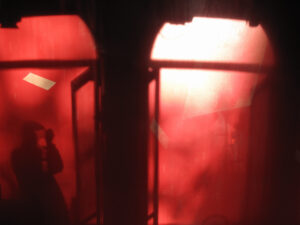06 Oct Colour in the Shadows: Edinburgh Event
Join us for a free half-day cross-disciplinary seminar on 6 October 2025 hosted by the University of Edinburgh which will bring together artists, designers, students, researchers and educators.
From the historical cabinets of curiosity to the neurological mechanisms of visual processing, from philosophical perspectives on colour constancy to the materiality of architectural spaces, our distinguished speakers will illuminate the multifaceted nature of shadows in colour experience.
This event offers a unique opportunity to bridge scientific understanding and artistic practice, fostering dialogue between different approaches to colour and shadow phenomena.
Date and Time: Monday, 6 October 2025, 1:45 PM – 5:00 PM
Venue: University of Edinburgh, 7 George Square, Room G32, Edinburgh
Registration Information
This event is free to attend, but registration is required via Eventbrite:
Programme
1:45 PM – Registration
1:50 PM – Welcome – Dr Jasna Martinovic and Prof. Fiona McLachlan
Presenter 1: Professor Irene Brown
Presentation Title: Shadow as Motivation and Medium
 Biography: Professor Irene Brown is Professor of Contemporary Art Practice at Newcastle University. She is a sculptor and site-specific installationist. Her research and practice is engaged with wonder, focusing on the history and philosophy of science, specifically cabinets of curiosity (wonder cabinets), investigating the threshold between aesthetic and scientific realms. She works directly in response to place, usually a museum or heritage site, using a broad range of media including sculpture, video, virtual reality and augmented reality. She is co-author of Wonder in Contemporary Art Practice (Routledge, 2017).
Biography: Professor Irene Brown is Professor of Contemporary Art Practice at Newcastle University. She is a sculptor and site-specific installationist. Her research and practice is engaged with wonder, focusing on the history and philosophy of science, specifically cabinets of curiosity (wonder cabinets), investigating the threshold between aesthetic and scientific realms. She works directly in response to place, usually a museum or heritage site, using a broad range of media including sculpture, video, virtual reality and augmented reality. She is co-author of Wonder in Contemporary Art Practice (Routledge, 2017).
Website: www.irenebrown.co.uk/project/wonder-in-contemporary-art-practice
Presentation Abstract: Irene will outline how many years of visiting museums in search of the remnants of cabinets of curiosity have influenced her research and practice. She’ll describe her fascination for a time when the distinctions between magic and science, and art and science, were far less clear than they seem today.
Presenter 2: Dr Derek H. Brown
Presentation Title: Colour and Shadows in Life and Art
 Biography: Dr Derek H. Brown is a Reader in Philosophy and Deputy Director for the Centre of for the Study of Perceptual Experience at the University of Glasgow. He is the UK PI of Sensory Engineering, an AHRC-DFG funded project (2024-2027). He primarily works on the nature of colour and colour perception, and on ways technologies manipulate sensory perceptions. He is the co-author of Colour Illusions Exist (Routledge 2025) and the co-editor of the Routledge Handbook of Philosophy of Colour (Routledge 2023).
Biography: Dr Derek H. Brown is a Reader in Philosophy and Deputy Director for the Centre of for the Study of Perceptual Experience at the University of Glasgow. He is the UK PI of Sensory Engineering, an AHRC-DFG funded project (2024-2027). He primarily works on the nature of colour and colour perception, and on ways technologies manipulate sensory perceptions. He is the co-author of Colour Illusions Exist (Routledge 2025) and the co-editor of the Routledge Handbook of Philosophy of Colour (Routledge 2023).
Presentation Abstract: Derek will first provide an overview of the phenomenon of colour constancy– the extent to which we perceive objects to have stable colours across changes in illumination conditions– outlining the nature of relevant data, the impact of instructional effects, and different ways of interpreting relevant perceptual experiences and defending the colour layering interpretation of colour constancy. He will then apply these issues to renderings of colours and shadows in digital scenes, highlighting different ways that colours and shadows can be constructed in different virtual environments, emphasizing ways that realistic virtual scenes can be created by illusory constructions (and vice versa).
3:10 PM – 3:40 PM – Tea Break
Presenter 3: Dr Ana Rozman
Presentation Title: Seeing Colour Through Shadows: How the Brain Constructs Colour Appearance
 Biography: Dr Ana Rozman is a post-doctoral research fellow in the Vision Lab at the School of Psychology at Sussex University. She is interested in how the brain processes colour signals to build colour representations, and how neuroimaging and psychophysical methods can be used to study these mechanisms. She completed her PhD titled Neural Mechanisms of Saturation at the University of Aberdeen under supervision of Dr Jasna Martinovic and Professor Louise Phillips. Prior to studying human colour vision, Ana obtained a BA(Hons) in Film and Media with Psychology from the University of Stirling.
Biography: Dr Ana Rozman is a post-doctoral research fellow in the Vision Lab at the School of Psychology at Sussex University. She is interested in how the brain processes colour signals to build colour representations, and how neuroimaging and psychophysical methods can be used to study these mechanisms. She completed her PhD titled Neural Mechanisms of Saturation at the University of Aberdeen under supervision of Dr Jasna Martinovic and Professor Louise Phillips. Prior to studying human colour vision, Ana obtained a BA(Hons) in Film and Media with Psychology from the University of Stirling.
Presentation Abstract: Colour appearance is not a reflection of the physical world but rather a construction of the brain. Our perception of colour arises from the brain’s interpretation of light information in the environment, even when that information is ambiguous. This complex process is not only shaped by the environmental context but also by the limits of the brain’s own processing mechanisms- constraints that can influence what we see. For instance, how does the brain distinguish between a coloured surface that is dark and one that appears dark because it lies in shadow, despite both having identical physical properties? What features of visual processing make this distinction possible? In this talk, Ana will explore recent research that sheds light on how the brain constructs appearance from combined colour and luminance information.
Presenter 4: Antoni Malinowski
Presentation Title: Charged Shades
 Biography: Antoni Malinowski is an artist/painter who works with pigment, light, movement and time, investigating the dynamic relationship that exists between pictorial and architectural spaces. He makes temporary and permanent interventions into buildings and has collaborated with several eminent architects on permanent wall paintings in architecture such as Spectral Flip at the Mathematical Institute in Oxford and at the Everyman Theatre in Liverpool. His work is discussed in McLachlan, F., Colour Beyond the Surface: Art in Architecture (Routledge, 2022).
Biography: Antoni Malinowski is an artist/painter who works with pigment, light, movement and time, investigating the dynamic relationship that exists between pictorial and architectural spaces. He makes temporary and permanent interventions into buildings and has collaborated with several eminent architects on permanent wall paintings in architecture such as Spectral Flip at the Mathematical Institute in Oxford and at the Everyman Theatre in Liverpool. His work is discussed in McLachlan, F., Colour Beyond the Surface: Art in Architecture (Routledge, 2022).
Presentation Abstract: The talk focuses on the phenomenology of shadows. The colour and the tonality of shadows provides visual information about the characteristics of light. The micro-materiality of surfaces interacts with the light of place. This interaction differs depending on where on Earth it is happening. The chromatic phenomenon is observed by painters and in-turn it influences their palette.
5:00 PM – Close

